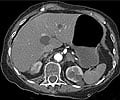
"We have demonstrated for the first time that the extracellular matrix (ECM) produced by fibroblasts following stimulation with cigarette smoke extract is functionally different than non-exposed ECM, and that the cigarette smoke itself may prime the airways in such a way to create an environment whereby airway remodelling is encouraged," wrote lead researcher David Krimmer of the University of Sydney in Australia.
The researchers examined the response of human lung tissue from donors with and without COPD to cigarette smoke extract (CSE).
They found that CSE exposure induced a significant increase in fibronectin deposition from the tissue of donors with COPD over the tissue of individuals without COPD.
Similarly, they found that CSE upregulated the expression of perlecan-an ECM protein that is associated with tumour growth and angiogenesis-in COPD lung tissue.
Perhaps the most striking finding of the study was that the CSE-induced ECM caused fibroblasts to proliferate.
Advertisement
"Together these findings paint a picture of how ECM may itself perpetuate the disease process of COPD long after patients have quit smoking," he added.
Advertisement
Source-ANI













